Mission Australia: Exploring the Charity's Role in Australia
VerifiedAdded on 2023/06/04
|10
|2215
|450
Report
AI Summary
This report provides a comprehensive overview of Mission Australia, a prominent non-denominational Christian charity in Australia. Founded in 1862, the organization has a long history of supporting vulnerable Australians through various services. The report details Mission Australia's mission to address homelessness, aid disadvantaged families and children, and tackle mental health and substance abuse issues. It explores the organization's diverse portfolios, including research and advocacy, employment services, community services, and services for families, children, and youth. The report highlights the stakeholders involved, including the executive committee, employees, and various community organizations. It also analyzes how Mission Australia fits into the modern capitalist economy through research and advocacy, influencing social policy and welfare reforms. The report uses information from Mission Australia's official website and other scholarly sources to present a detailed and insightful analysis of the charity's operations and impact.
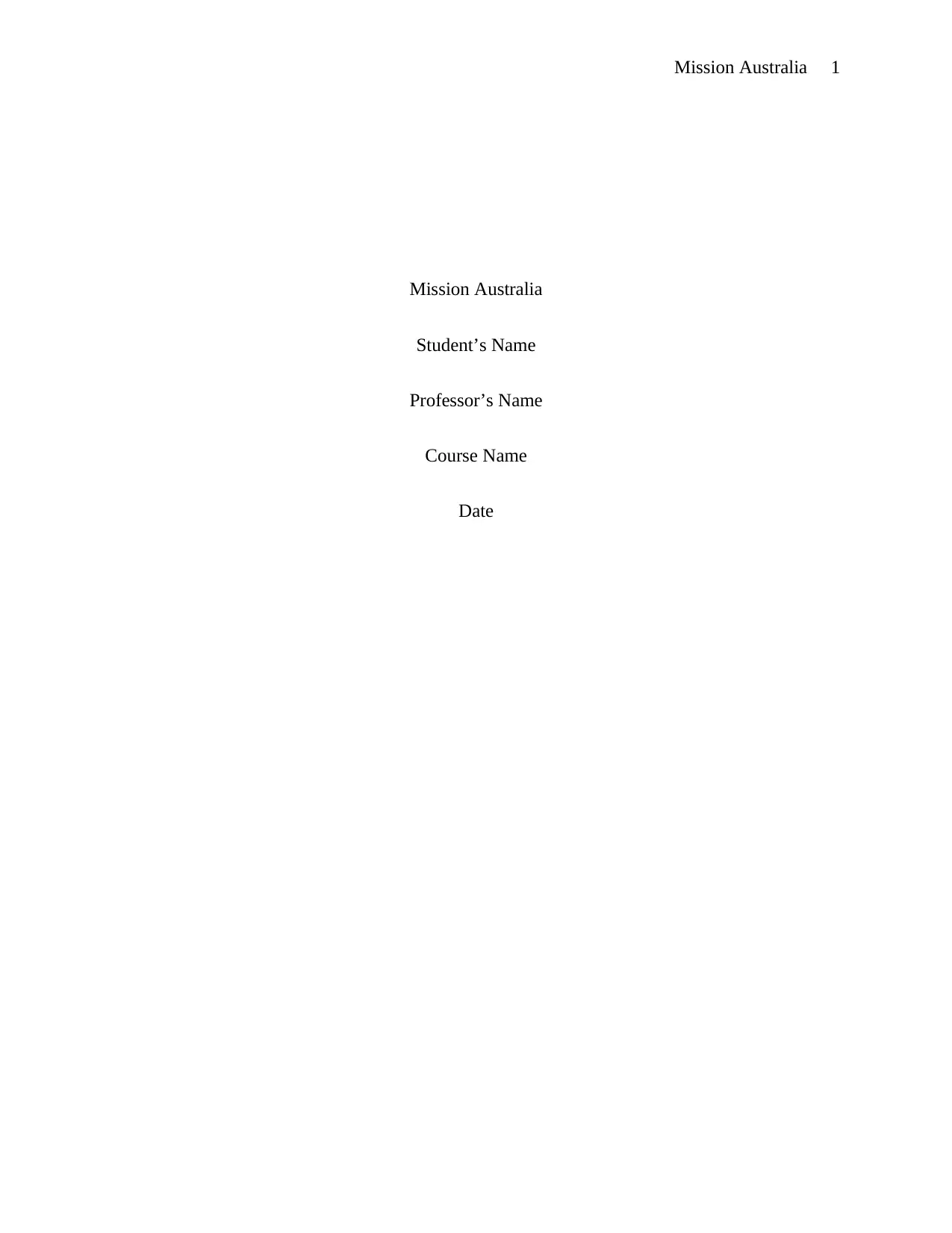
Mission Australia 1
Mission Australia
Student’s Name
Professor’s Name
Course Name
Date
Mission Australia
Student’s Name
Professor’s Name
Course Name
Date
Paraphrase This Document
Need a fresh take? Get an instant paraphrase of this document with our AI Paraphraser
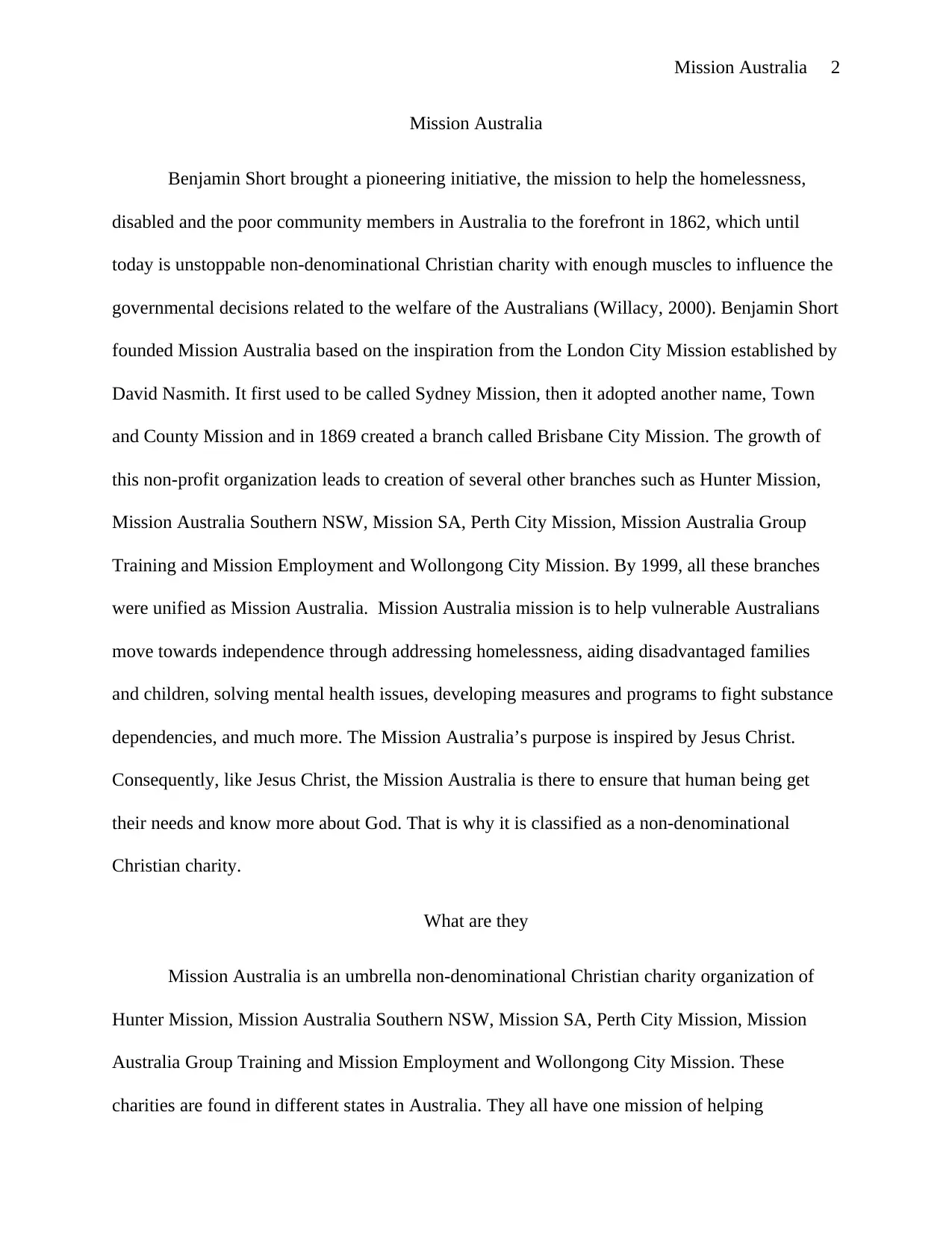
Mission Australia 2
Mission Australia
Benjamin Short brought a pioneering initiative, the mission to help the homelessness,
disabled and the poor community members in Australia to the forefront in 1862, which until
today is unstoppable non-denominational Christian charity with enough muscles to influence the
governmental decisions related to the welfare of the Australians (Willacy, 2000). Benjamin Short
founded Mission Australia based on the inspiration from the London City Mission established by
David Nasmith. It first used to be called Sydney Mission, then it adopted another name, Town
and County Mission and in 1869 created a branch called Brisbane City Mission. The growth of
this non-profit organization leads to creation of several other branches such as Hunter Mission,
Mission Australia Southern NSW, Mission SA, Perth City Mission, Mission Australia Group
Training and Mission Employment and Wollongong City Mission. By 1999, all these branches
were unified as Mission Australia. Mission Australia mission is to help vulnerable Australians
move towards independence through addressing homelessness, aiding disadvantaged families
and children, solving mental health issues, developing measures and programs to fight substance
dependencies, and much more. The Mission Australia’s purpose is inspired by Jesus Christ.
Consequently, like Jesus Christ, the Mission Australia is there to ensure that human being get
their needs and know more about God. That is why it is classified as a non-denominational
Christian charity.
What are they
Mission Australia is an umbrella non-denominational Christian charity organization of
Hunter Mission, Mission Australia Southern NSW, Mission SA, Perth City Mission, Mission
Australia Group Training and Mission Employment and Wollongong City Mission. These
charities are found in different states in Australia. They all have one mission of helping
Mission Australia
Benjamin Short brought a pioneering initiative, the mission to help the homelessness,
disabled and the poor community members in Australia to the forefront in 1862, which until
today is unstoppable non-denominational Christian charity with enough muscles to influence the
governmental decisions related to the welfare of the Australians (Willacy, 2000). Benjamin Short
founded Mission Australia based on the inspiration from the London City Mission established by
David Nasmith. It first used to be called Sydney Mission, then it adopted another name, Town
and County Mission and in 1869 created a branch called Brisbane City Mission. The growth of
this non-profit organization leads to creation of several other branches such as Hunter Mission,
Mission Australia Southern NSW, Mission SA, Perth City Mission, Mission Australia Group
Training and Mission Employment and Wollongong City Mission. By 1999, all these branches
were unified as Mission Australia. Mission Australia mission is to help vulnerable Australians
move towards independence through addressing homelessness, aiding disadvantaged families
and children, solving mental health issues, developing measures and programs to fight substance
dependencies, and much more. The Mission Australia’s purpose is inspired by Jesus Christ.
Consequently, like Jesus Christ, the Mission Australia is there to ensure that human being get
their needs and know more about God. That is why it is classified as a non-denominational
Christian charity.
What are they
Mission Australia is an umbrella non-denominational Christian charity organization of
Hunter Mission, Mission Australia Southern NSW, Mission SA, Perth City Mission, Mission
Australia Group Training and Mission Employment and Wollongong City Mission. These
charities are found in different states in Australia. They all have one mission of helping
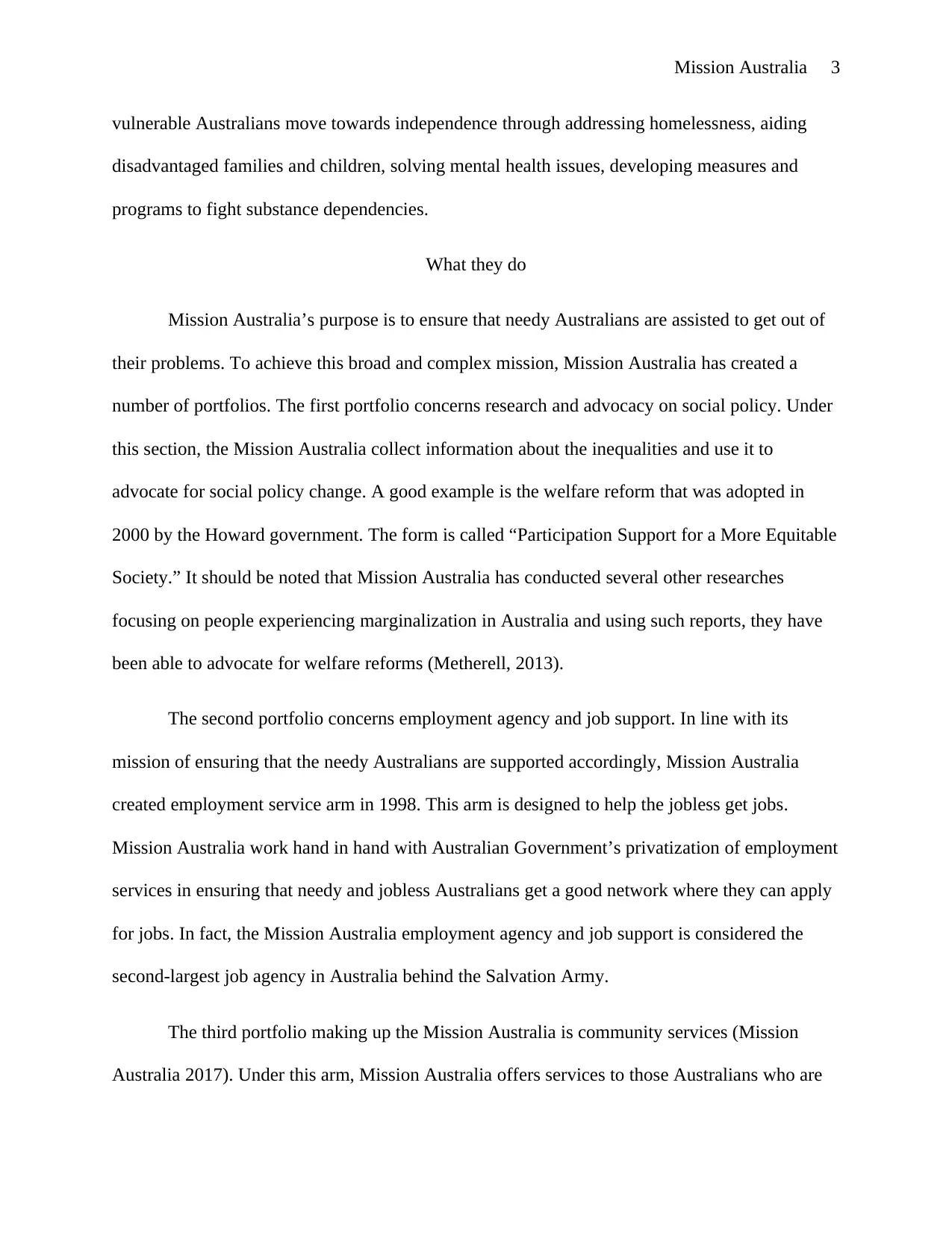
Mission Australia 3
vulnerable Australians move towards independence through addressing homelessness, aiding
disadvantaged families and children, solving mental health issues, developing measures and
programs to fight substance dependencies.
What they do
Mission Australia’s purpose is to ensure that needy Australians are assisted to get out of
their problems. To achieve this broad and complex mission, Mission Australia has created a
number of portfolios. The first portfolio concerns research and advocacy on social policy. Under
this section, the Mission Australia collect information about the inequalities and use it to
advocate for social policy change. A good example is the welfare reform that was adopted in
2000 by the Howard government. The form is called “Participation Support for a More Equitable
Society.” It should be noted that Mission Australia has conducted several other researches
focusing on people experiencing marginalization in Australia and using such reports, they have
been able to advocate for welfare reforms (Metherell, 2013).
The second portfolio concerns employment agency and job support. In line with its
mission of ensuring that the needy Australians are supported accordingly, Mission Australia
created employment service arm in 1998. This arm is designed to help the jobless get jobs.
Mission Australia work hand in hand with Australian Government’s privatization of employment
services in ensuring that needy and jobless Australians get a good network where they can apply
for jobs. In fact, the Mission Australia employment agency and job support is considered the
second-largest job agency in Australia behind the Salvation Army.
The third portfolio making up the Mission Australia is community services (Mission
Australia 2017). Under this arm, Mission Australia offers services to those Australians who are
vulnerable Australians move towards independence through addressing homelessness, aiding
disadvantaged families and children, solving mental health issues, developing measures and
programs to fight substance dependencies.
What they do
Mission Australia’s purpose is to ensure that needy Australians are assisted to get out of
their problems. To achieve this broad and complex mission, Mission Australia has created a
number of portfolios. The first portfolio concerns research and advocacy on social policy. Under
this section, the Mission Australia collect information about the inequalities and use it to
advocate for social policy change. A good example is the welfare reform that was adopted in
2000 by the Howard government. The form is called “Participation Support for a More Equitable
Society.” It should be noted that Mission Australia has conducted several other researches
focusing on people experiencing marginalization in Australia and using such reports, they have
been able to advocate for welfare reforms (Metherell, 2013).
The second portfolio concerns employment agency and job support. In line with its
mission of ensuring that the needy Australians are supported accordingly, Mission Australia
created employment service arm in 1998. This arm is designed to help the jobless get jobs.
Mission Australia work hand in hand with Australian Government’s privatization of employment
services in ensuring that needy and jobless Australians get a good network where they can apply
for jobs. In fact, the Mission Australia employment agency and job support is considered the
second-largest job agency in Australia behind the Salvation Army.
The third portfolio making up the Mission Australia is community services (Mission
Australia 2017). Under this arm, Mission Australia offers services to those Australians who are
⊘ This is a preview!⊘
Do you want full access?
Subscribe today to unlock all pages.

Trusted by 1+ million students worldwide
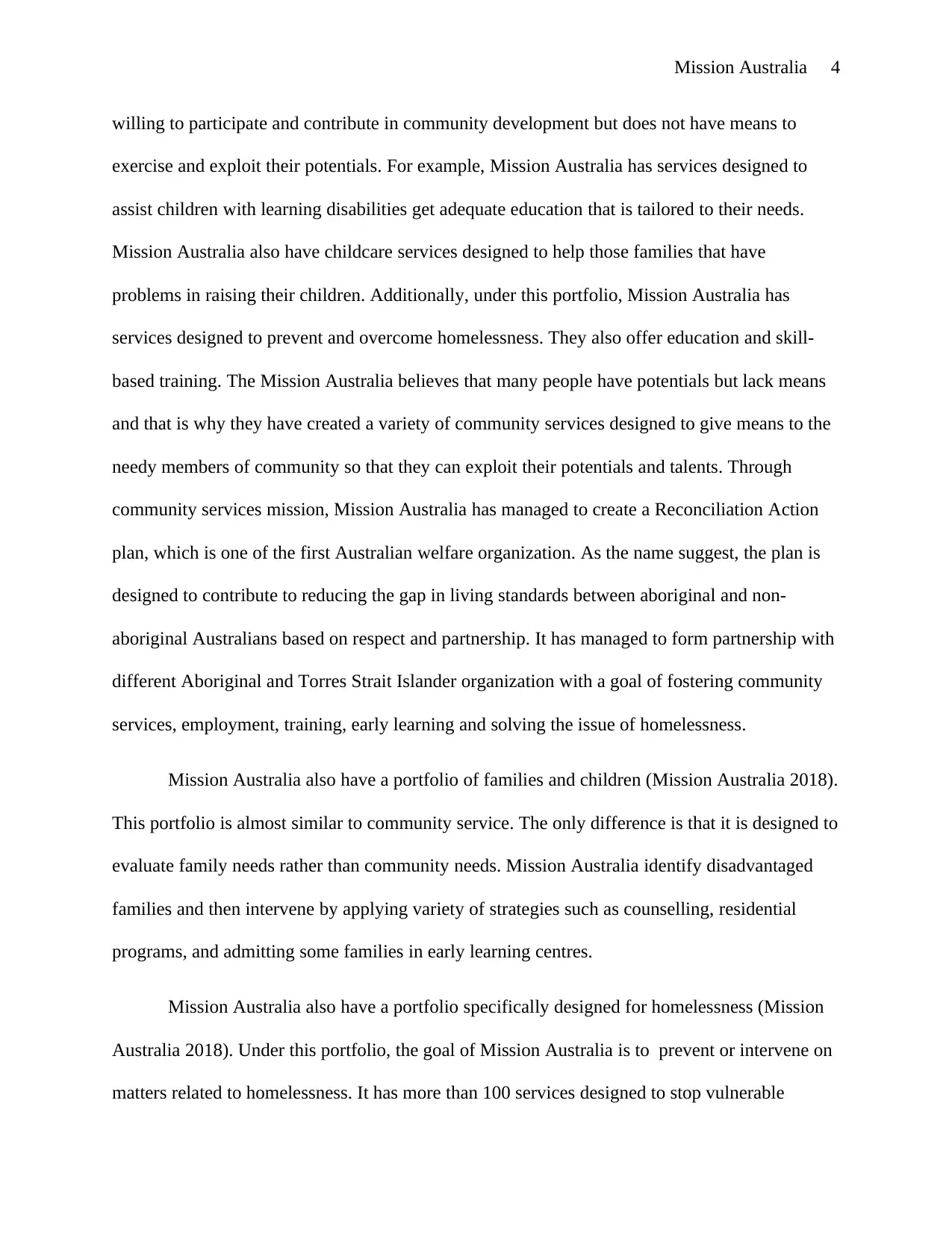
Mission Australia 4
willing to participate and contribute in community development but does not have means to
exercise and exploit their potentials. For example, Mission Australia has services designed to
assist children with learning disabilities get adequate education that is tailored to their needs.
Mission Australia also have childcare services designed to help those families that have
problems in raising their children. Additionally, under this portfolio, Mission Australia has
services designed to prevent and overcome homelessness. They also offer education and skill-
based training. The Mission Australia believes that many people have potentials but lack means
and that is why they have created a variety of community services designed to give means to the
needy members of community so that they can exploit their potentials and talents. Through
community services mission, Mission Australia has managed to create a Reconciliation Action
plan, which is one of the first Australian welfare organization. As the name suggest, the plan is
designed to contribute to reducing the gap in living standards between aboriginal and non-
aboriginal Australians based on respect and partnership. It has managed to form partnership with
different Aboriginal and Torres Strait Islander organization with a goal of fostering community
services, employment, training, early learning and solving the issue of homelessness.
Mission Australia also have a portfolio of families and children (Mission Australia 2018).
This portfolio is almost similar to community service. The only difference is that it is designed to
evaluate family needs rather than community needs. Mission Australia identify disadvantaged
families and then intervene by applying variety of strategies such as counselling, residential
programs, and admitting some families in early learning centres.
Mission Australia also have a portfolio specifically designed for homelessness (Mission
Australia 2018). Under this portfolio, the goal of Mission Australia is to prevent or intervene on
matters related to homelessness. It has more than 100 services designed to stop vulnerable
willing to participate and contribute in community development but does not have means to
exercise and exploit their potentials. For example, Mission Australia has services designed to
assist children with learning disabilities get adequate education that is tailored to their needs.
Mission Australia also have childcare services designed to help those families that have
problems in raising their children. Additionally, under this portfolio, Mission Australia has
services designed to prevent and overcome homelessness. They also offer education and skill-
based training. The Mission Australia believes that many people have potentials but lack means
and that is why they have created a variety of community services designed to give means to the
needy members of community so that they can exploit their potentials and talents. Through
community services mission, Mission Australia has managed to create a Reconciliation Action
plan, which is one of the first Australian welfare organization. As the name suggest, the plan is
designed to contribute to reducing the gap in living standards between aboriginal and non-
aboriginal Australians based on respect and partnership. It has managed to form partnership with
different Aboriginal and Torres Strait Islander organization with a goal of fostering community
services, employment, training, early learning and solving the issue of homelessness.
Mission Australia also have a portfolio of families and children (Mission Australia 2018).
This portfolio is almost similar to community service. The only difference is that it is designed to
evaluate family needs rather than community needs. Mission Australia identify disadvantaged
families and then intervene by applying variety of strategies such as counselling, residential
programs, and admitting some families in early learning centres.
Mission Australia also have a portfolio specifically designed for homelessness (Mission
Australia 2018). Under this portfolio, the goal of Mission Australia is to prevent or intervene on
matters related to homelessness. It has more than 100 services designed to stop vulnerable
Paraphrase This Document
Need a fresh take? Get an instant paraphrase of this document with our AI Paraphraser
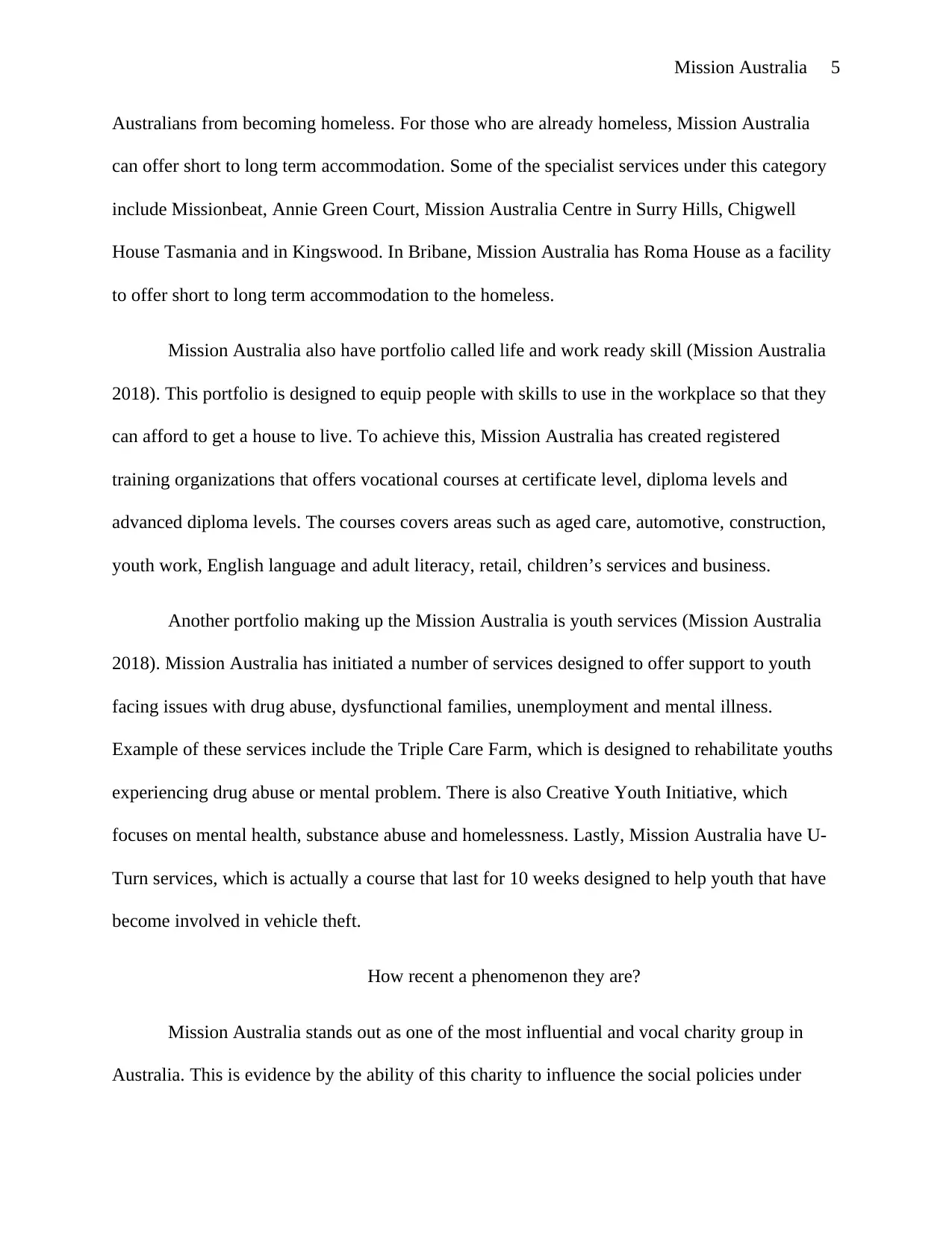
Mission Australia 5
Australians from becoming homeless. For those who are already homeless, Mission Australia
can offer short to long term accommodation. Some of the specialist services under this category
include Missionbeat, Annie Green Court, Mission Australia Centre in Surry Hills, Chigwell
House Tasmania and in Kingswood. In Bribane, Mission Australia has Roma House as a facility
to offer short to long term accommodation to the homeless.
Mission Australia also have portfolio called life and work ready skill (Mission Australia
2018). This portfolio is designed to equip people with skills to use in the workplace so that they
can afford to get a house to live. To achieve this, Mission Australia has created registered
training organizations that offers vocational courses at certificate level, diploma levels and
advanced diploma levels. The courses covers areas such as aged care, automotive, construction,
youth work, English language and adult literacy, retail, children’s services and business.
Another portfolio making up the Mission Australia is youth services (Mission Australia
2018). Mission Australia has initiated a number of services designed to offer support to youth
facing issues with drug abuse, dysfunctional families, unemployment and mental illness.
Example of these services include the Triple Care Farm, which is designed to rehabilitate youths
experiencing drug abuse or mental problem. There is also Creative Youth Initiative, which
focuses on mental health, substance abuse and homelessness. Lastly, Mission Australia have U-
Turn services, which is actually a course that last for 10 weeks designed to help youth that have
become involved in vehicle theft.
How recent a phenomenon they are?
Mission Australia stands out as one of the most influential and vocal charity group in
Australia. This is evidence by the ability of this charity to influence the social policies under
Australians from becoming homeless. For those who are already homeless, Mission Australia
can offer short to long term accommodation. Some of the specialist services under this category
include Missionbeat, Annie Green Court, Mission Australia Centre in Surry Hills, Chigwell
House Tasmania and in Kingswood. In Bribane, Mission Australia has Roma House as a facility
to offer short to long term accommodation to the homeless.
Mission Australia also have portfolio called life and work ready skill (Mission Australia
2018). This portfolio is designed to equip people with skills to use in the workplace so that they
can afford to get a house to live. To achieve this, Mission Australia has created registered
training organizations that offers vocational courses at certificate level, diploma levels and
advanced diploma levels. The courses covers areas such as aged care, automotive, construction,
youth work, English language and adult literacy, retail, children’s services and business.
Another portfolio making up the Mission Australia is youth services (Mission Australia
2018). Mission Australia has initiated a number of services designed to offer support to youth
facing issues with drug abuse, dysfunctional families, unemployment and mental illness.
Example of these services include the Triple Care Farm, which is designed to rehabilitate youths
experiencing drug abuse or mental problem. There is also Creative Youth Initiative, which
focuses on mental health, substance abuse and homelessness. Lastly, Mission Australia have U-
Turn services, which is actually a course that last for 10 weeks designed to help youth that have
become involved in vehicle theft.
How recent a phenomenon they are?
Mission Australia stands out as one of the most influential and vocal charity group in
Australia. This is evidence by the ability of this charity to influence the social policies under
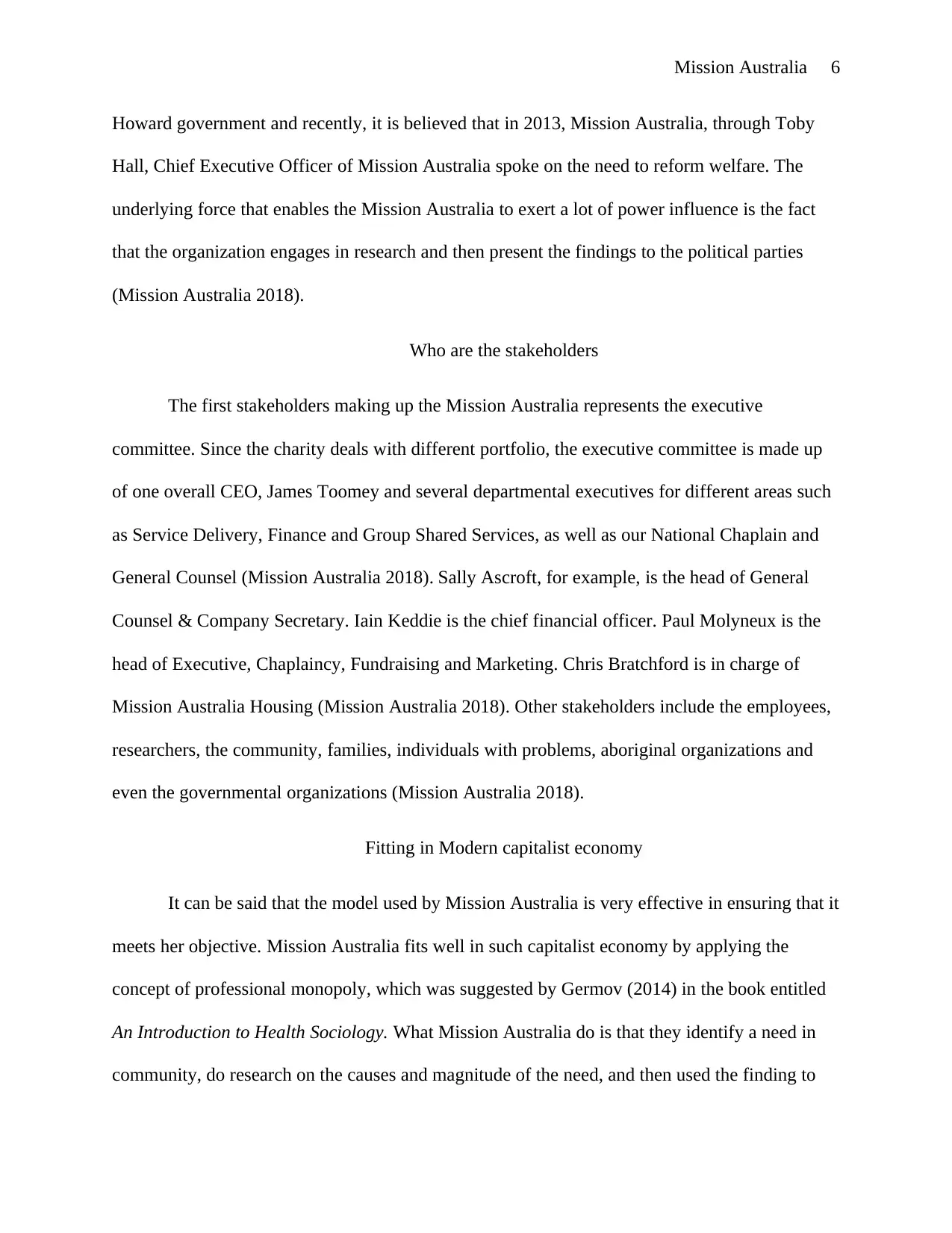
Mission Australia 6
Howard government and recently, it is believed that in 2013, Mission Australia, through Toby
Hall, Chief Executive Officer of Mission Australia spoke on the need to reform welfare. The
underlying force that enables the Mission Australia to exert a lot of power influence is the fact
that the organization engages in research and then present the findings to the political parties
(Mission Australia 2018).
Who are the stakeholders
The first stakeholders making up the Mission Australia represents the executive
committee. Since the charity deals with different portfolio, the executive committee is made up
of one overall CEO, James Toomey and several departmental executives for different areas such
as Service Delivery, Finance and Group Shared Services, as well as our National Chaplain and
General Counsel (Mission Australia 2018). Sally Ascroft, for example, is the head of General
Counsel & Company Secretary. Iain Keddie is the chief financial officer. Paul Molyneux is the
head of Executive, Chaplaincy, Fundraising and Marketing. Chris Bratchford is in charge of
Mission Australia Housing (Mission Australia 2018). Other stakeholders include the employees,
researchers, the community, families, individuals with problems, aboriginal organizations and
even the governmental organizations (Mission Australia 2018).
Fitting in Modern capitalist economy
It can be said that the model used by Mission Australia is very effective in ensuring that it
meets her objective. Mission Australia fits well in such capitalist economy by applying the
concept of professional monopoly, which was suggested by Germov (2014) in the book entitled
An Introduction to Health Sociology. What Mission Australia do is that they identify a need in
community, do research on the causes and magnitude of the need, and then used the finding to
Howard government and recently, it is believed that in 2013, Mission Australia, through Toby
Hall, Chief Executive Officer of Mission Australia spoke on the need to reform welfare. The
underlying force that enables the Mission Australia to exert a lot of power influence is the fact
that the organization engages in research and then present the findings to the political parties
(Mission Australia 2018).
Who are the stakeholders
The first stakeholders making up the Mission Australia represents the executive
committee. Since the charity deals with different portfolio, the executive committee is made up
of one overall CEO, James Toomey and several departmental executives for different areas such
as Service Delivery, Finance and Group Shared Services, as well as our National Chaplain and
General Counsel (Mission Australia 2018). Sally Ascroft, for example, is the head of General
Counsel & Company Secretary. Iain Keddie is the chief financial officer. Paul Molyneux is the
head of Executive, Chaplaincy, Fundraising and Marketing. Chris Bratchford is in charge of
Mission Australia Housing (Mission Australia 2018). Other stakeholders include the employees,
researchers, the community, families, individuals with problems, aboriginal organizations and
even the governmental organizations (Mission Australia 2018).
Fitting in Modern capitalist economy
It can be said that the model used by Mission Australia is very effective in ensuring that it
meets her objective. Mission Australia fits well in such capitalist economy by applying the
concept of professional monopoly, which was suggested by Germov (2014) in the book entitled
An Introduction to Health Sociology. What Mission Australia do is that they identify a need in
community, do research on the causes and magnitude of the need, and then used the finding to
⊘ This is a preview!⊘
Do you want full access?
Subscribe today to unlock all pages.

Trusted by 1+ million students worldwide
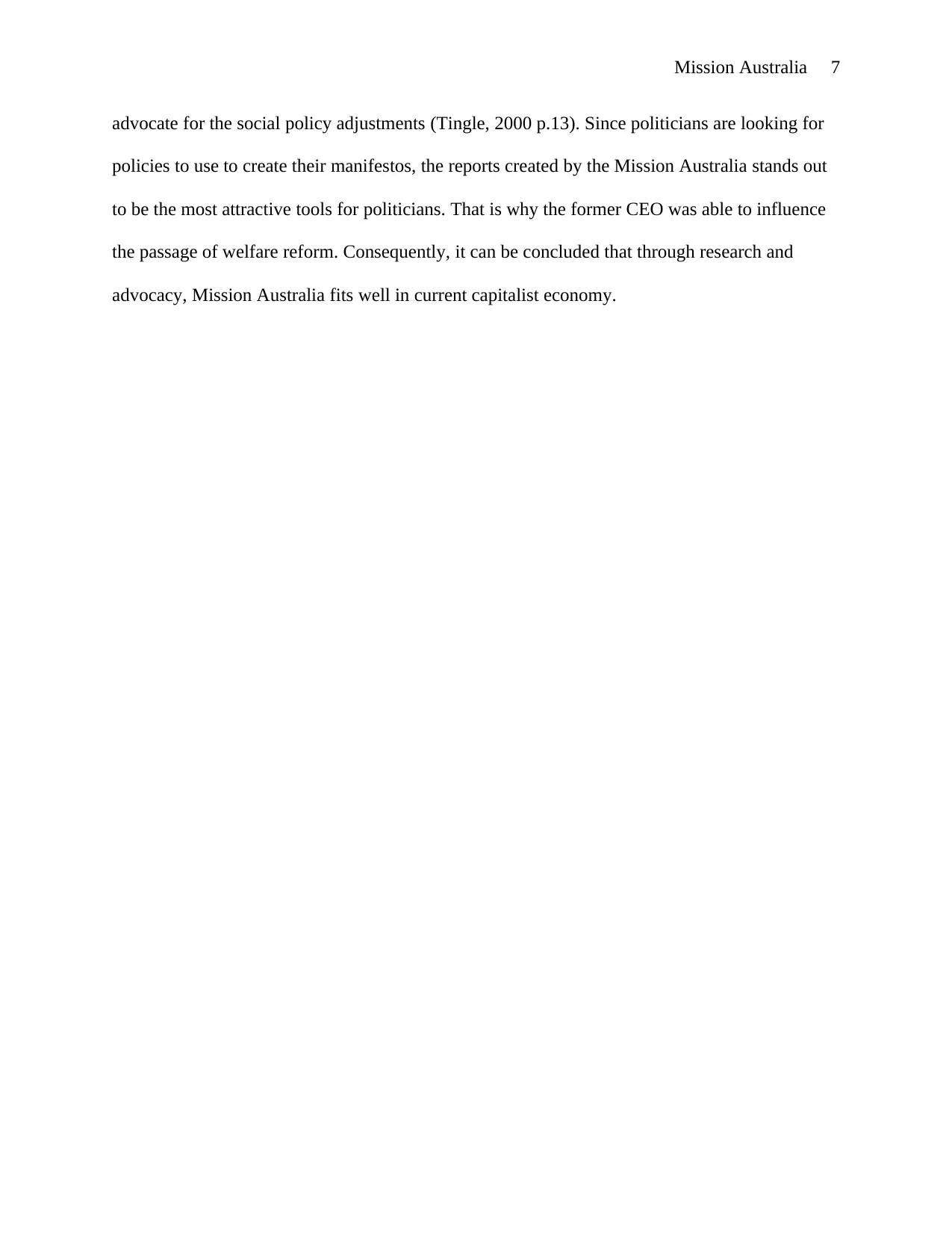
Mission Australia 7
advocate for the social policy adjustments (Tingle, 2000 p.13). Since politicians are looking for
policies to use to create their manifestos, the reports created by the Mission Australia stands out
to be the most attractive tools for politicians. That is why the former CEO was able to influence
the passage of welfare reform. Consequently, it can be concluded that through research and
advocacy, Mission Australia fits well in current capitalist economy.
advocate for the social policy adjustments (Tingle, 2000 p.13). Since politicians are looking for
policies to use to create their manifestos, the reports created by the Mission Australia stands out
to be the most attractive tools for politicians. That is why the former CEO was able to influence
the passage of welfare reform. Consequently, it can be concluded that through research and
advocacy, Mission Australia fits well in current capitalist economy.
Paraphrase This Document
Need a fresh take? Get an instant paraphrase of this document with our AI Paraphraser
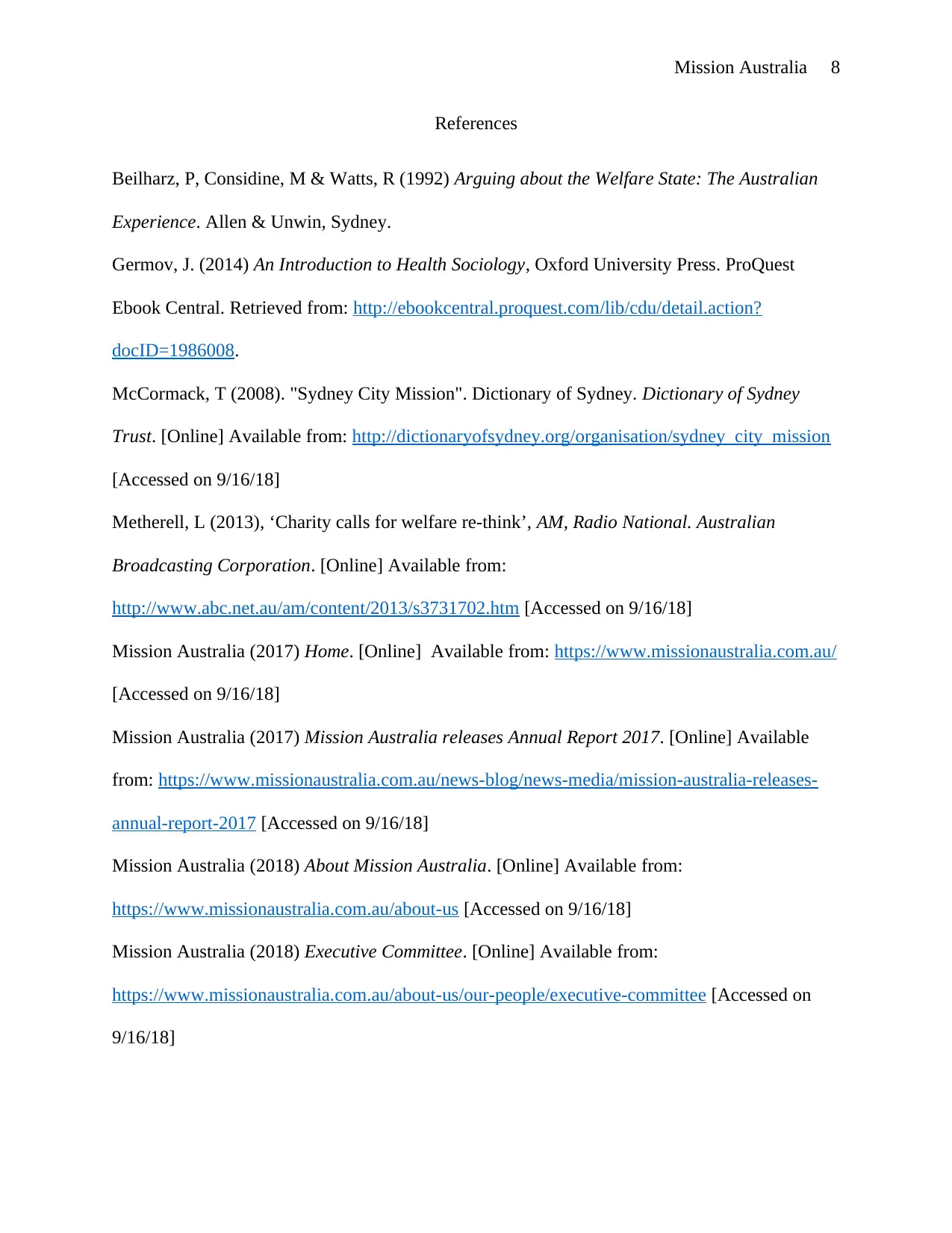
Mission Australia 8
References
Beilharz, P, Considine, M & Watts, R (1992) Arguing about the Welfare State: The Australian
Experience. Allen & Unwin, Sydney.
Germov, J. (2014) An Introduction to Health Sociology, Oxford University Press. ProQuest
Ebook Central. Retrieved from: http://ebookcentral.proquest.com/lib/cdu/detail.action?
docID=1986008.
McCormack, T (2008). "Sydney City Mission". Dictionary of Sydney. Dictionary of Sydney
Trust. [Online] Available from: http://dictionaryofsydney.org/organisation/sydney_city_mission
[Accessed on 9/16/18]
Metherell, L (2013), ‘Charity calls for welfare re-think’, AM, Radio National. Australian
Broadcasting Corporation. [Online] Available from:
http://www.abc.net.au/am/content/2013/s3731702.htm [Accessed on 9/16/18]
Mission Australia (2017) Home. [Online] Available from: https://www.missionaustralia.com.au/
[Accessed on 9/16/18]
Mission Australia (2017) Mission Australia releases Annual Report 2017. [Online] Available
from: https://www.missionaustralia.com.au/news-blog/news-media/mission-australia-releases-
annual-report-2017 [Accessed on 9/16/18]
Mission Australia (2018) About Mission Australia. [Online] Available from:
https://www.missionaustralia.com.au/about-us [Accessed on 9/16/18]
Mission Australia (2018) Executive Committee. [Online] Available from:
https://www.missionaustralia.com.au/about-us/our-people/executive-committee [Accessed on
9/16/18]
References
Beilharz, P, Considine, M & Watts, R (1992) Arguing about the Welfare State: The Australian
Experience. Allen & Unwin, Sydney.
Germov, J. (2014) An Introduction to Health Sociology, Oxford University Press. ProQuest
Ebook Central. Retrieved from: http://ebookcentral.proquest.com/lib/cdu/detail.action?
docID=1986008.
McCormack, T (2008). "Sydney City Mission". Dictionary of Sydney. Dictionary of Sydney
Trust. [Online] Available from: http://dictionaryofsydney.org/organisation/sydney_city_mission
[Accessed on 9/16/18]
Metherell, L (2013), ‘Charity calls for welfare re-think’, AM, Radio National. Australian
Broadcasting Corporation. [Online] Available from:
http://www.abc.net.au/am/content/2013/s3731702.htm [Accessed on 9/16/18]
Mission Australia (2017) Home. [Online] Available from: https://www.missionaustralia.com.au/
[Accessed on 9/16/18]
Mission Australia (2017) Mission Australia releases Annual Report 2017. [Online] Available
from: https://www.missionaustralia.com.au/news-blog/news-media/mission-australia-releases-
annual-report-2017 [Accessed on 9/16/18]
Mission Australia (2018) About Mission Australia. [Online] Available from:
https://www.missionaustralia.com.au/about-us [Accessed on 9/16/18]
Mission Australia (2018) Executive Committee. [Online] Available from:
https://www.missionaustralia.com.au/about-us/our-people/executive-committee [Accessed on
9/16/18]
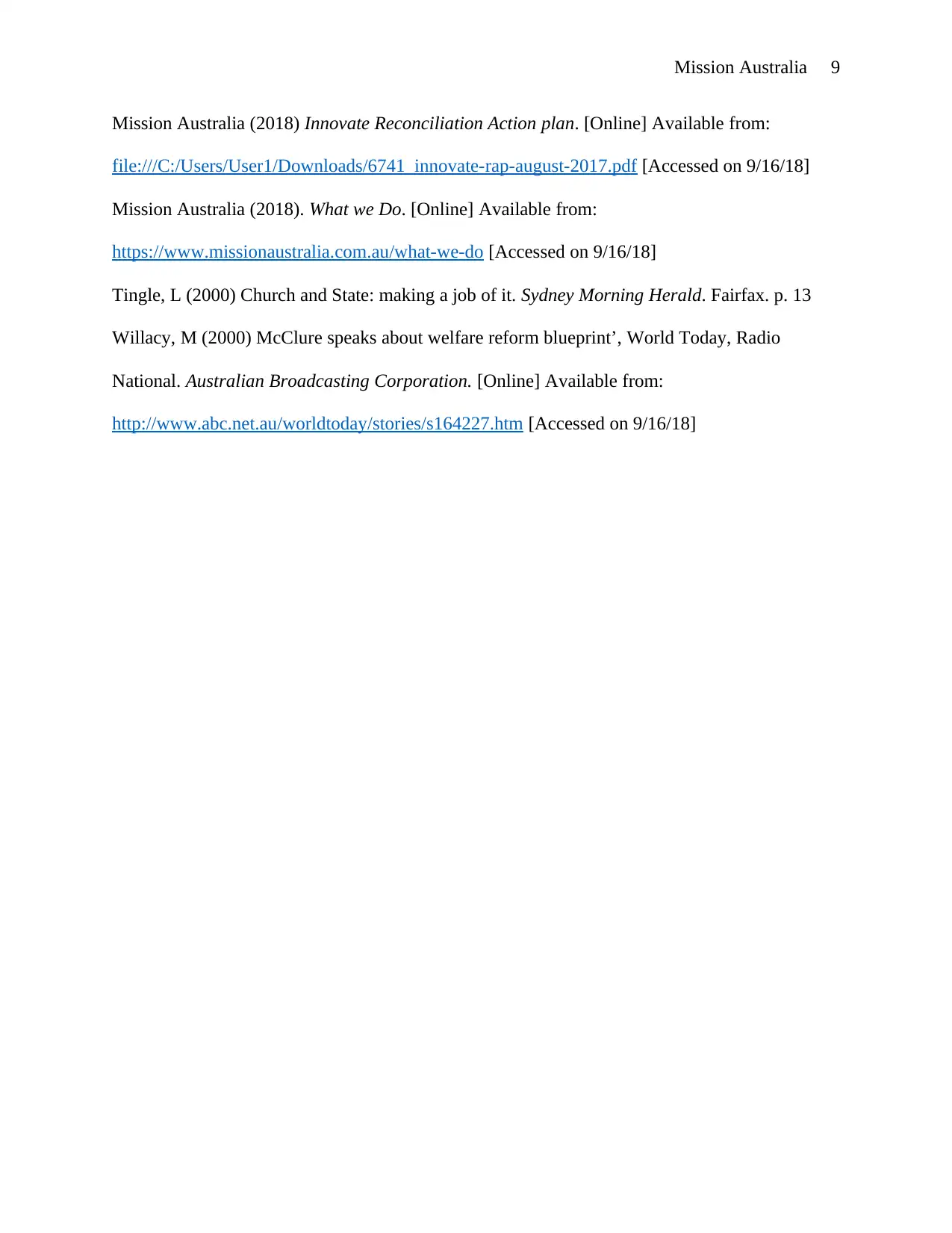
Mission Australia 9
Mission Australia (2018) Innovate Reconciliation Action plan. [Online] Available from:
file:///C:/Users/User1/Downloads/6741_innovate-rap-august-2017.pdf [Accessed on 9/16/18]
Mission Australia (2018). What we Do. [Online] Available from:
https://www.missionaustralia.com.au/what-we-do [Accessed on 9/16/18]
Tingle, L (2000) Church and State: making a job of it. Sydney Morning Herald. Fairfax. p. 13
Willacy, M (2000) McClure speaks about welfare reform blueprint’, World Today, Radio
National. Australian Broadcasting Corporation. [Online] Available from:
http://www.abc.net.au/worldtoday/stories/s164227.htm [Accessed on 9/16/18]
Mission Australia (2018) Innovate Reconciliation Action plan. [Online] Available from:
file:///C:/Users/User1/Downloads/6741_innovate-rap-august-2017.pdf [Accessed on 9/16/18]
Mission Australia (2018). What we Do. [Online] Available from:
https://www.missionaustralia.com.au/what-we-do [Accessed on 9/16/18]
Tingle, L (2000) Church and State: making a job of it. Sydney Morning Herald. Fairfax. p. 13
Willacy, M (2000) McClure speaks about welfare reform blueprint’, World Today, Radio
National. Australian Broadcasting Corporation. [Online] Available from:
http://www.abc.net.au/worldtoday/stories/s164227.htm [Accessed on 9/16/18]
⊘ This is a preview!⊘
Do you want full access?
Subscribe today to unlock all pages.

Trusted by 1+ million students worldwide
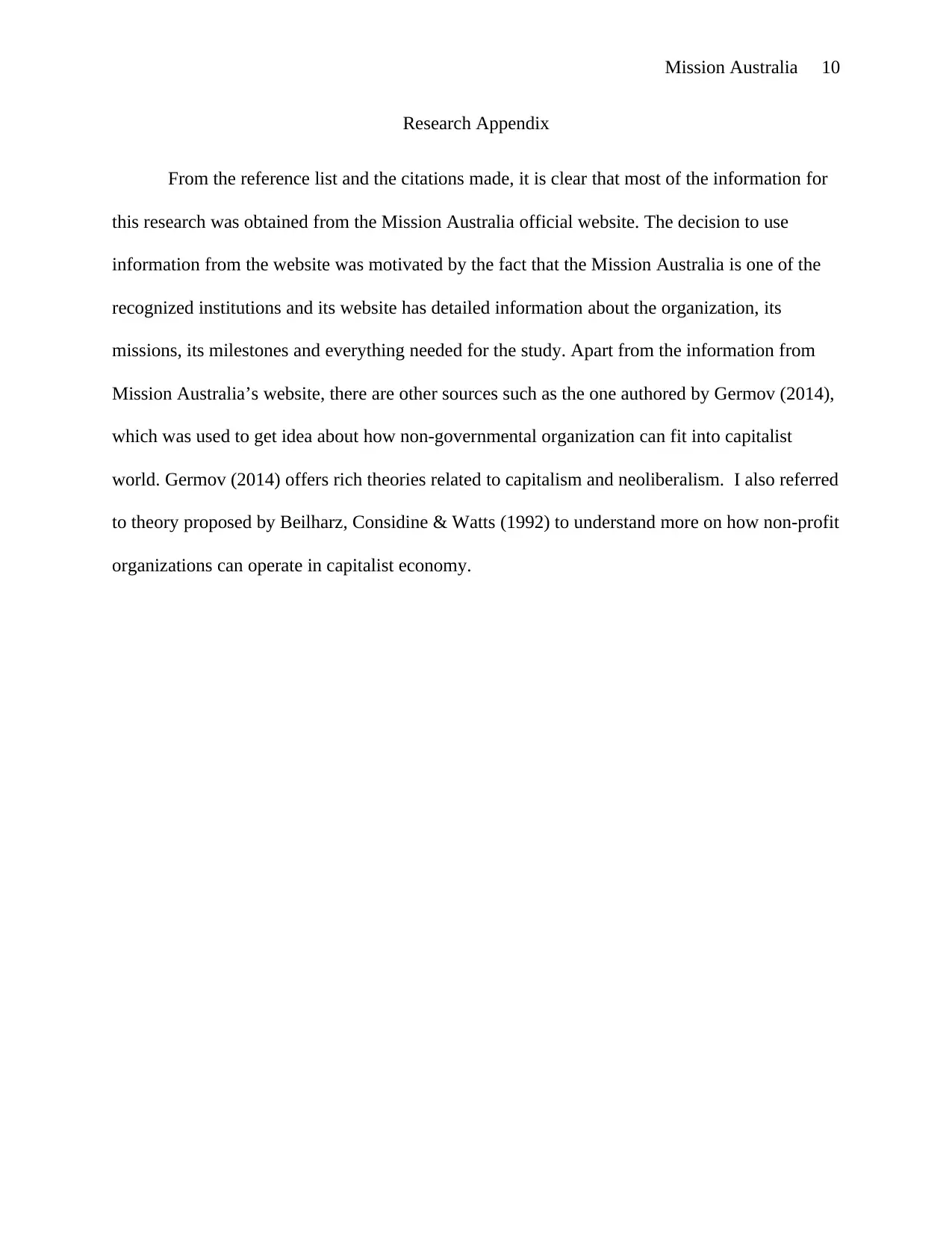
Mission Australia 10
Research Appendix
From the reference list and the citations made, it is clear that most of the information for
this research was obtained from the Mission Australia official website. The decision to use
information from the website was motivated by the fact that the Mission Australia is one of the
recognized institutions and its website has detailed information about the organization, its
missions, its milestones and everything needed for the study. Apart from the information from
Mission Australia’s website, there are other sources such as the one authored by Germov (2014),
which was used to get idea about how non-governmental organization can fit into capitalist
world. Germov (2014) offers rich theories related to capitalism and neoliberalism. I also referred
to theory proposed by Beilharz, Considine & Watts (1992) to understand more on how non-profit
organizations can operate in capitalist economy.
Research Appendix
From the reference list and the citations made, it is clear that most of the information for
this research was obtained from the Mission Australia official website. The decision to use
information from the website was motivated by the fact that the Mission Australia is one of the
recognized institutions and its website has detailed information about the organization, its
missions, its milestones and everything needed for the study. Apart from the information from
Mission Australia’s website, there are other sources such as the one authored by Germov (2014),
which was used to get idea about how non-governmental organization can fit into capitalist
world. Germov (2014) offers rich theories related to capitalism and neoliberalism. I also referred
to theory proposed by Beilharz, Considine & Watts (1992) to understand more on how non-profit
organizations can operate in capitalist economy.
1 out of 10
Your All-in-One AI-Powered Toolkit for Academic Success.
+13062052269
info@desklib.com
Available 24*7 on WhatsApp / Email
![[object Object]](/_next/static/media/star-bottom.7253800d.svg)
Unlock your academic potential
Copyright © 2020–2025 A2Z Services. All Rights Reserved. Developed and managed by ZUCOL.